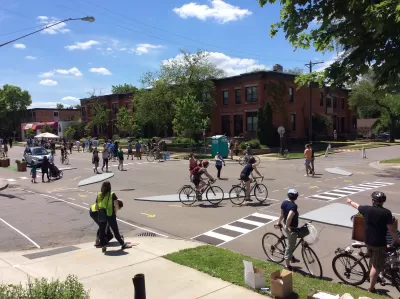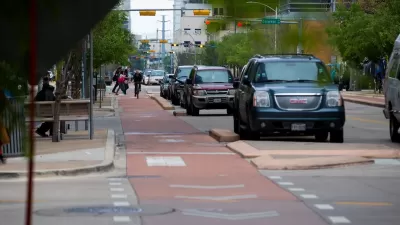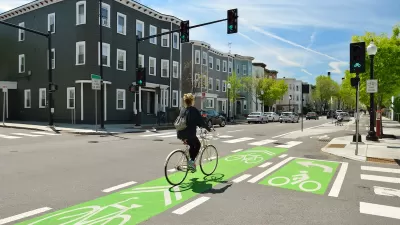A new guide seeks to answer that question for any street in the world.

The National Association of City Transportation Officials has released a guide to determining what kind of bike infrastructure to install on any given street. It's one of the most comprehensive such guides in the nation, according to Michael Andersen.
By analyzing the basic components of streets—like auto speed, traffic volume, and lane count—NACTO's formula can recommend a type of bike lane for a street with any combination of those factors. For example:
Got a two-lane, two-way 25 mph street that carries 4,000 autos per day? According to NACTO, a buffered bike lane will do. But if the traffic speed is 30 mph, it’s time to protect the bike lane with a curb, posts or planters.
In some cases, the guide also recommends changing the variables that make stricter precautions necessary in the first place—such as by slowing vehicular traffic to reduce the number and speed of cars passing by bike riders. Overall, the calculations are aimed at producing a "high-comfort" experience for riders "of all ages and abilities"—a higher standard than many existing local guides, Andersen points out.
FULL STORY: Which Bike Lanes Should Be Protected? New Guide Offers Specifics

Planetizen Federal Action Tracker
A weekly monitor of how Trump’s orders and actions are impacting planners and planning in America.

Maui's Vacation Rental Debate Turns Ugly
Verbal attacks, misinformation campaigns and fistfights plague a high-stakes debate to convert thousands of vacation rentals into long-term housing.

Restaurant Patios Were a Pandemic Win — Why Were They so Hard to Keep?
Social distancing requirements and changes in travel patterns prompted cities to pilot new uses for street and sidewalk space. Then it got complicated.

In California Battle of Housing vs. Environment, Housing Just Won
A new state law significantly limits the power of CEQA, an environmental review law that served as a powerful tool for blocking new development.

Boulder Eliminates Parking Minimums Citywide
Officials estimate the cost of building a single underground parking space at up to $100,000.

Orange County, Florida Adopts Largest US “Sprawl Repair” Code
The ‘Orange Code’ seeks to rectify decades of sprawl-inducing, car-oriented development.
Urban Design for Planners 1: Software Tools
This six-course series explores essential urban design concepts using open source software and equips planners with the tools they need to participate fully in the urban design process.
Planning for Universal Design
Learn the tools for implementing Universal Design in planning regulations.
Heyer Gruel & Associates PA
JM Goldson LLC
Custer County Colorado
City of Camden Redevelopment Agency
City of Astoria
Transportation Research & Education Center (TREC) at Portland State University
Jefferson Parish Government
Camden Redevelopment Agency
City of Claremont





























